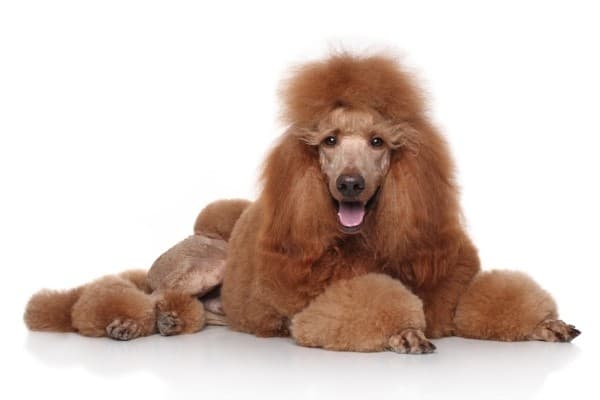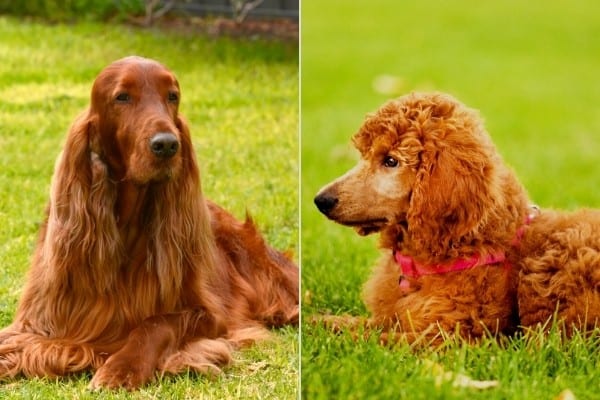
Table of Contents
With so many Poodle crosses available today, deciding on the right one for you can be challenging.
Popular Doodles, such as Cockapoos, Goldendoodles, and Labradoodles are pretty commonplace, but other Poodle mixes, like the Irish Doodle, aren’t as well known.
What is an Irish Doodle? An Irish Doodle is a designer breed created from Irish Setters and Poodles. They can weigh up to 65 pounds and are common in various shades of red. This mix is relatively healthy and will require about an hour of exercise each day and routine grooming.
If you’re attracted to the more uncommon Doodles and don’t mind turning heads whenever you take your new pup for a walk, the Irish Doodle is definitely worth considering.
As you read through the following, you’ll learn what exactly makes these dogs so special and whether or not this is the breed for you.
What Is an Irish Doodle?
An Irish Doodle is a cross between the lovely Irish Setter and the dignified Poodle. They are also known as Irish Poodles, Irish Setter Doodles, Irish Setter Poos, and Irish Poos.
A fairly new designer breed, this mix is steadily gaining popularity thanks to the sweet, gentle personalities and low-shedding tendencies.
Irish Doodles at a Glance: Irish Doodle Facts
| Origin | Irish Setter and Poodle |
| Sizes | Standard and Mini |
| Height | Standard: 18 – 27 inches
Mini: 12 – 20 inches |
| Weight | Standard: 45 – 65 pounds
Mini: 25 – 40 pounds |
| Purpose | Mainly companion |
| Colors | Shades of red are most common |
| Coat | Long and soft, varies between wavy and curly |
| Temperament | Affectionate, gentle, playful, loyal, eager to please |
| Aggressive? | No |
| Good family dog? | Yes |
| Good with other pets? | Yes |
| Energy level | Fairly high |
| Exercise needs | 60 minutes or more each day |
| Cost | Average: $2,000 – $3,000 |
| Excessive barking? | No |
| Hypoallergenic? | High probability |
| Shedding | Low |
| Grooming requirements | Moderate |
| Intelligence | High |
| Trainability | Easy to train |
| Protective? | Yes |
| Good guard dog? | No |
| Health issues | May inherit conditions from parent breeds |
| Life expectancy | 12 – 15 years |
What to Expect With a Mixed Breed
Mixed breed dogs will exhibit features of both parents, though puppies from the same litter can vary quite a bit.
Perhaps you’ve heard that positive traits are reinforced when two different breeds are interbred.
This can be true; however, negative traits can also be strengthened through careless or irresponsible breeding.
If you obtain a mix from a reputable breeder, you can expect to find certain traits, such as low-shedding, to have been intentionally strengthened.
With good breeding practices, extreme traits, such as a high-prey drive, tend to disappear, resulting in a great-all-around puppy.
For Irish Doodles, expect a perfect combination of the Irish Setter’s grace, athleticism, and easy-going, affectionate nature with the Poodle’s superb intelligence and trainability, low-shedding coat, and hypoallergenic qualities.
Irish Doodle History
No one knows for certain how the Irish Doodle came to be.
Certainly there have been plenty of accidental breedings when a neighboring dog was attracted to a bitch in heat; however, the point when purposeful mixing of the Irish Setter and the Poodle became the goal is unclear.
What we do know is that both parent breeds have been around for hundreds of years and possess qualities that combine ideally when interbred.
Irish Setter History

Due to the passage of time and lack of breeding records, the Irish Setter’s history is rather obscure.
It is commonly believed that the earliest ancestors of the breed were created by mixing Spaniel-type dogs from Spain with popular Irish breeds.
Certainly other breeds were added along the way – most likely English and Gordon Setters, other Spaniels, and perhaps Pointers – to achieve desired traits and to form a reliable hunting dog that could adapt to various conditions in the field.
Originally, solid red was not the norm, and most dogs called Irish Setters were red and white.
Over time, however, the most notable breeders developed a preference for the solid red coats, and the breed’s standard began to solidify in the late 1800s.
In 1878 Irish Setters were granted full recognition by the American Kennel Club (AKC).
Irish Setters, according to current breed standards are to be tall, elegant in appearance, rangy in build, swift moving, and richly colored.
However, two distinct “types” have emerged through the years – the show type and the field, or working, type.
Two “Types”
Show-type Irish Setters are what you probably picture when you think about the breed.
Breeders focus on appearance and temperament, but, according to some, this focus sacrificed many of the top-notch hunting qualities the breed was known and loved for.
Thus, the field-type Irish Setter began to gain popularity, particularly among hunters. Emphasis is placed more on hunting ability and traits that enable the dog to excel in the field.
So, what exactly is the difference?
Show dogs are taller, heavier, and lankier with a luxurious coat and longer feathering on the chest, tail, and legs.
Field dogs, commonly called Red Setters, are shorter, lighter, and blockier throughout the body. The neck and legs are shorter as is the coat and its associated feathering.
They have a reputation for having a more fluid gate and as being smarter, easier to train, and more eager to please. Their lifespan is slightly longer on average than show-type dogs.
The difference is significant in terms of appearance, and those seeking a hunting dog naturally gravitate to the field type.
That said, there are plenty of breeders today working diligently to breed more desirable hunting traits back into show stock.
Note that the Irish Setter, regardless of type, is not to be confused with the Irish Red and White Setter (that’s a separate breed entirely), though now that you are familiar with the Irish Setter’s history, you can guess how the red and white breed came to be.
Irish Setters can be expected to live for approximately 12 – 15 years, though many factors play a role in determining the length of life.
Table of Contents
Poodle History

Contrary to what many people believe, the Poodle did not originate in France, though it is the national dog of the country.
Poodles actually were created in Germany, and the breed name reflects that fact.
Púddln is a German word meaning “to splash in water” or “puddle,” and indeed, the Poodle was, and is, a water-loving dog originally bred to hunt ducks.
In France, Poodles are referred to as the Caniche or Chien Canard, which translate roughly to “duck dog.”
In England, Poodles were once known as the “rough water dog.”
It is thought that sometime in the 1600s several water-retrieving dogs, most notably the Barbet (discover this recently recognized breed here), from European countries were interbred to create the distinct features that are hallmarks of the breed today.
The trademark low-shedding, curly, dense coat was developed to protect the body while the dog was hunting in adverse conditions.
Seemingly elaborate grooming styles further emphasize the coat’s protective nature as the thick pompons protect joints and the tip of the tail and the thicker areas left on the body protect vital organs.
Originally, all Poodles were either solid black, solid white, or black and white.
Today, there are 10 standard colors and many combinations of these colors in what are known as parti-colored dogs.
The Poodle’s high intelligence was purposely bred into the breed to make these already adept and skilled hunters excel even more in their role and train easily.
Table of Contents
Additional Roles
It was soon discovered that the Poodle was useful for more than just hunting.
Poodles were used extensively in circuses and other forms of entertainment, such as street performances.
Poodles have since proved valuable in other roles, such as guard dog, military dog, assistance dog, truffle-finder and other special-skill jobs.
Standard size Poodles were eventually bred down to create the Miniature Poodle, and over time the Minis were used to develop the Toy Poodle.
Poodles were officially recognized by the American Kennel Club in 1887, though the breakdown into different varieties came much later.
No matter the variety of Poodle, the same breed standard applies.
Many Poodles live well into their late teens, though Standard Poodles seem to have a slightly shorter lifespan.
What Does an Irish Doodle Look Like?

Because Irish Doodles are a mixed breed, appearances can vary, largely based upon the type and color of Poodle used in the breeding.
Irish Doodles resemble large, red teddy bears and are often mistaken for Labradoodles or Goldendoodles.
They are sturdy and rugged – a perfect combination of the Irish Setter’s athletic build and the elegance of the Poodle.
A large breed often nearing 70 pounds, Irish Doodles have large, somewhat narrow heads with low-set, long ears; dark, oval eyes; and long muzzles usually broader than that of a Poodle.
The body is squarely built with long, muscular legs, a deep chest, and a long, well-furred tail.
They have physical characteristics of both parent breeds, but because of the copious amounts of shaggy fur, their bone structure is not as evident.
The chiseled Poodle features are softened and the Setter feathering vanishes.
Do Irish Doodles Have Docked Tails?
While it is still a common practice for Poodles to have their tails docked several days after birth, Irish Doodles’ tails are not docked but left in their natural condition.
Tail docking was once done with the belief that the procedure would prevent future injury to the tail.
However, today docking is performed solely for cosmetic reasons or to adhere to breed standards, as is the case with Poodles.
How Many Sizes of Irish Doodles Are There?
As Irish Doodles are not an officially recognized breed, there is not a written set of breed standards for breeders to follow.
This leaves breeders with a lot of freedom as far as breeding decisions and terminology are concerned.
The two most common Irish Doodle sizes available are Standard and Miniature, though breeders might refer to a Mini as a Medium.
While it is likely that Toy Poodles will eventually be used to produce smaller sizes, this is not yet a common practice as artificial insemination would be required.
Other breeders use Moyen Poodles in their breeding program to produce a dog that falls somewhere between the large and medium sizes.
Standard Irish Doodle
A standard Irish Doodle is the result of breeding an Irish Setter with a Standard Poodle. This is the largest variety available and is currently the most common size.
As is the case with most breeds, males are typically slightly taller, heavier, and bulkier.
Height
The average height of Standard Irish Doodles is between 18 – 27 inches tall at the shoulder.
Male Standard Poodles are typically over 15 inches, and Irish Setters average 25 (female) and 27 (male) inches, which explains the wide allowance for Standard Irish Doodle height.
Weight
Standard Irish Doodles are typically between 45 and 65 pounds at adulthood.
This is logical as male Standard Poodles are 60 – 70 pounds and female Irish Setters are typically under 60 pounds.
Mini (or Medium) Irish Doodle
A female Irish Setter crossed with a male Miniature Poodle produces a Mini Irish Doodle, which is significantly smaller than the Standards but is steadily gaining popularity.
Expect males to fall in the higher ranges for height and weight.
Height
Most Mini Irish Doodles will stand somewhere between 12 and 20 inches at the shoulder, though this can vary.
Males usually grow taller, but depending on gene interaction, females may exceed averages if they take after their Setter mom.
Weight
Because of the extreme weight differences between an Irish Setter and Mini Poodle, weight of Mini Irish Doodles can be hard to predict; however many will be between 25 and 40 pounds.
Moyen Irish Doodle
Moyen Poodles are not a recognized variety by the AKC, but several breeders are experimenting with Moyen to Irish Setter breedings to produce pups who will be smaller than Standards but larger than Minis.
Height
Between 15 and 25 inches tall at the shoulder is typical for Moyen Irish Doodles. Here again, this can vary.
Weight
Most Moyen Irish Doodle breeders claim that 35 – 45 pounds is standard for this size category.
| Size | Standard | Mini | Moyen |
| Height | 18 – 27 inches | 12 – 20 inches | 15 – 25 inches |
| Weight | 45 – 65 pounds | 25 – 40 pounds | 35 – 45 pounds |
When Is an Irish Doodle Full Grown?
Standard Irish Doodles will typically reach their full height within 12 months but will continue to gain weight and fill out until 18 months of age.
The smaller sizes will grow at a faster rate and will often reach adult height in the first nine months and be fully grown by their first birthday or shortly thereafter.
Know that the end of physical growth doesn’t necessarily mean that mental maturity has been reached as well.
Puppy behavior is common up until 2 years of age in any breed, but Irish Setters are known for retaining puppy characteristics for as long as four years.
So, if your Irish Doodle takes after his Setter side, puppy antics may take a long time to disappear.
Irish Doodle Colors
The majority of Irish Doodles are created by combining an Irish Setter with a red Standard Poodle and will be red, though shades may vary from a golden, light red to a deeper mahogany color.
White patches of color are common and typically occur on the face and chest.
However, other colors are possible depending on the color of the Poodle sire and on the generation of pup (a multigen puppy may be born an entirely different color than either of his parents depending on the inherited genes).
Black and apricot colors are fairly common, and other popular Poodle colors, such as silver, brown, cream, and blue pop up occasionally as well, especially in generations F1b and beyond.
Parti-colored dogs, especially red and white combinations, are seen in this mixed breed as well.
Do Irish Doodles Change Colors?
While other Poodle crosses, such as Goldendoodles (learn more about this popular mix here), often experience a lightening of coat color as they age, this is not generally the case with Irish Doodles.
A slight change may be noted as the puppy coat transitions to the adult coat around 4 – 6 months of age, but a vast change should not be expected.
The only exception may be for black Doodles as fading to a silver tone is common in older dogs.
Irish Doodle Coat
Irish Doodles have a soft, thick, wavy coat more relaxed than that of a Poodle and fuller than that of an Irish Setter.
Some coats will be curlier than others, but all will grow to be quite long and shaggy when left untrimmed.
Do Irish Doodles Have a Double Coat?
The Irish Setter breed is double coated, but the Poodle is not.
The majority of Irish Doodles will have a single coat that is dense like a Poodle’s but soft and wavy without the tight curls.
Irish Doodle Temperament
Irish Setters are known for being loving, playful, and happy-go-lucky. According to the AKC breed standard for the Irish Setter:
“The Irish Setter has a rollicking personality. Shyness, hostility or timidity are uncharacteristic of the breed. An outgoing, stable temperament is the essence of the Irish Setter.”
Poodles are known for being highly intelligent and easy to train, playful yet dignified, and alert.
Combine these traits with the Setter’s stable character, and the result is a near perfect temperament.
Although the way in which a dog is raised and socialized can influence temperament to a certain extent, you’ll find that the overwhelming majority of Irish Doodles have an outstanding temperament.
Irish Poos possess all the qualities of an ideal dog: affectionate, gentle, playful, eager to please, devoted to their family, and a joy to own.
Are Irish Doodles Aggressive?
Neither of the parent breeds are aggressive, and the same is true for Irish Doodles.
Of course, any dog pushed to his limits or not properly socialized has the potential for aggression, but for an Irish Doodle raised in a loving home, aggressive behavior should never be an issue.
Are Irish Doodles Cuddly?
This mixed breed, without question, is quite affectionate and loves to snuggle.
When not running off excess energy outdoors, Irish Doodles are laid back and easy going, always ready to cuddle up beside you on the couch to soak up some attention.
Cuddles, snuggles, hugs, pets, kisses – you name it, they enjoy it!
Are Irish Doodles Loyal?
Irish Doodles bond quickly with their new family and love being around their loved ones regardless of the current activity.
These sociable mixed dogs easily make friends with strangers, but their family will always firmly remain in first place in their hearts.
Are Irish Doodles Good Family Dogs?
This crossbreed is an excellent choice for families. Irish Doodles are wonderful with children of all ages and are known for their patience and gentleness.
Whether the family is enjoying outdoor fun or relaxing inside, the Irish Doodle is content as long as he’s around those he loves.
Are Irish Doodles Good With Other Dogs?
Irish Doodles typically get along well with other dogs, both in the home and those encountered on outings.
Of course, this is dependent on the attitude of the other dog, but generally, you shouldn’t have to worry about your Irish Doodle being aggressive toward other dogs.
Are Irish Doodles Good With Cats?
Most Irish Doodles have no problem with household cats, especially if they have been raised together.
A stray cat strolling through the yard may instigate a chase response, but that is typical behavior for any dog regardless of breed.
Irish Doodle Energy Level
Although most Irish Doodles won’t be quite as energetic as Irish Setters, they are in no way couch potatoes either.
Best described as active and energetic, this crossbreed will be more than willing to participate in all kinds of outdoor fun with the family.
As long as they are permitted to burn through energy outside each day, they’ll settle right down when back indoors.
They really are the best of both worlds – fun and active outside, yet calm and well behaved indoors.
Table of Contents
Are Irish Doodles High Energy?
Irish Doodles with a higher percentage of Poodle in their bloodline may be slightly more laid back than others, but overall, this mix can be considered a moderately high-energy dog.
Irish Poos will fit right in with families who enjoy exercise and outdoor adventures or just playing around in the backyard.
They are generally not hyper or bouncing-off-the-walls energetic, but when not given sufficient exercise opportunities, excess energy may result in undesirable behavior.
How Much Exercise Does an Irish Doodle Need?
Some Doodles will require more exercise than others, but for most Irish Doodles, an hour or so of daily exercise broken up into two or three sessions is usually enough.
Forms of exercise can include:
- Walking.
- Jogging or running.
- Hiking.
- Swimming.
- Trips to the dog park.
- Fetch, Frisbee, tag, and other simple games.
- Running around with the kids as they play.
- Agility training and other dog sports.
How Much Do Irish Doodles Cost?
Occasionally you might find an Irish Doodle puppy for less than $2,000, but average prices tend to be between $2,000 and $3,000.
Some breeders may charge more for a particular color, size, sex, or white markings, and other breeders may offer a reduced price for pups with undesirable markings.
It really depends on the breeder and what is currently in demand.
While pricing certainly plays a part in deciding on a particular breeder, it is equally important to select a breeder based on the care they give their dogs and their love of the breed.
Quality breeders:
- Will perform multiple health screenings on both parents.
- Will raise the dogs indoors with the family.
- Won’t dissuade you from coming to their home to meet the puppies and the parent dogs.
- Will only have friendly, healthy dogs and clean living quarters.
- Have veterinary documentation attesting to the health of the pups.
- Will already have begun socializing the pups.
- Won’t hesitate to question you about your ability to provide a permanent, loving home.
Irish Doodle Puppy Care

Irish Doodle puppies need the same basic care as any other puppy: lots of love, attention, quality puppy food, supervision, and training.
Using a crate can help keep your puppy safe and speed housebreaking.
How to Potty Train an Irish Doodle
Housebreaking an Irish Doodle is really no different than for other breeds; however, because of their high intelligence, Irish Doodles might catch on a bit faster.
Potty training is really all about consistency.
A puppy will need to relieve himself every few hours as his system can only “hold it” for so long, typically one hour per month of age.
So, if your little Doodle is 2 months old, take him outside to a designated area every two hours without fail.
Let him sniff around while you repeat a phrase such as “Go pee.”
Have some training treats ready, (like these all-natural bite-size morsels), and the instant he heeds the call of nature, give him a treat or two and plenty of praise.
It really is that easy. Crate training can help make the process even faster as dogs by instinct don’t like to soil their sleeping quarters.
This article, though written with Labradoodles in mind, explains how easy and advantageous crate training can be.
Be consistent, offer lots of praise, and your Irish Doodle will be fully potty trained before you know it.
Irish Doodle Diet
Irish Doodles should do well on a high-quality, complete and balanced, commercial kibble, preferably one with meat as the first ingredient and free of grains and artificial colors, flavors, and additives.
In our Ultimate Guide to the Best Dog Food and Treats, we explain exactly what to look for and what to avoid.
A homemade diet is an option, but you should work in conjunction with your vet or canine nutritionist when developing menus to ensure all dietary needs are met.
Table of Contents
Do Irish Doodles Have Sensitive Stomachs?
Generally, tummy troubles are not common in this mixed breed.
Bloat is always something to watch for, however, as immediate medical intervention is the only answer.
Are Irish Doodles Yappy – Do Irish Doodles Bark a Lot?
Small breeds, like Toy Poodles, have a reputation for being borderline obnoxious when it comes to barking.
Irish Setters too can be prone to excessive barking when overly excited. Generally, Irish Doodles are relatively quiet.
That’s not to say that they won’t alert you when someone’s at the door or bark in sheer pleasure as they play outside, but nuisance barking is not a trademark of this crossbreed.
Providing the proper amount of daily exercise and correct socialization during puppyhood will go a long way in ensuring that barking doesn’t become an issue.
Are Irish Doodles Hypoallergenic?
No dog is 100% hypoallergenic as the proteins found in saliva, dander, and urine are what actually trigger an allergic response.
However, many Irish Doodles are well tolerated by allergy sufferers, especially Doodles with a heavy concentration of Poodle in their heritage.
Do Irish Doodles Shed?
As with any crossbreed, shedding tendencies will vary quite a bit, but Irish Doodles are considered to be relatively low shedding.
Those who are the result of one or more backcrosses to Poodles will be the least likely to shed, and even F1 generation pups tend to inherit the Poodle’s low-shedding qualities, so your chances of finding a low-shedding Irish Doodle are rather high.
Do Irish Doodle Puppies Shed?
Shedding will be quite minimal until your puppy reaches 4 – 6 months of age and begins to lose the puppy coat.
This is a gradual process that can take a few months to complete, so don’t expect to find huge, drifting heaps of fur around the house.
In fact, you may not notice the shed hair at all until brushing time as the lost hair is often trapped within the coat.
To prevent shed hair from forming painful mats, brush your little Doodle daily while the coat is transitioning.
Grooming an Irish Doodle
For an Irish Doodle, grooming is not negotiable, but it can be a perfect bonding opportunity as you both relax and enjoy the process.
A thorough brushing every few days (more often if the coat is long) will remove loose hair, prevent mats, stimulate the skin, distribute natural oils, and keep your dog looking and feeling his best.
Brushing time should also include a quick full-body checkup. Look for untreated scratches or cuts, hot spots, inflammation, pests, tender areas, and lumps or swellings.
In addition to an occasional bath, other routine grooming tasks include:
- Trimming – every six to eight weeks.
- Ear cleaning – every month or so.
- Nail trimming – every four to six weeks or as needed. See our how-to guide and supply list here.
- Brushing teeth – three or four times per week with a dog-safe toothpaste and brush.
Best Brush for an Irish Doodle
For the majority of coat care, a sturdy slicker brush with rounded ends is ideal.
I use this self-cleaning, comfort-grip slicker brush on my Doodles and find that it glides easily through the coat, removes loose hair and debris well, and doesn’t cause my dogs any discomfort.
In addition to a slicker brush, a steel, dual-sided comb is another must-have to gently work through tangles and the facial area.
Depending on your Doodle’s coat length, you may also want to invest in a dematting comb, like this gentle dematting tool, to slice through and remove mats without damaging surrounding fur.
| Preview | Product | Rating | |
|---|---|---|---|

|
Pettom Pet Steel Grooming Tool Poodle Finishing... | Check Price on Amazon | |

|
Poodle Pet Dematting Fur Rake Comb Brush Tool -... | Check Price on Amazon |
How Often Should You Bathe an Irish Doodle?
Unless your Irish Doodle is particularly filthy, a bath every couple of months is usually sufficient.
Excessive bathing can strip protective oils from the skin and coat and cause skin flaking, irritation, and itchiness.
Use a gentle, hypoallergenic shampoo and a detangling conditioner, and be sure to thoroughly brush out any tangles once the coat is dry. .
(I use this line of natural shampoos and this concentrated detangling conditioner on my own Doodles.)
Irish Doodle Grooming Styles
Owners of Irish Doodles may choose to have the coat clipped short for easy, fast daily grooming or may prefer a longer style that will require more intensive, frequent upkeep.
With longer coats, it’s recommended that hair around the eyes is trimmed to prevent eye irritation and obstructed vision and that any hair inside the ears is removed to allow for greater air flow and reduced risk of ear infections.
Irish Doodle Haircuts
Whether you trim your dog yourself or use the services of a professional groomer, you have a ton of styling choices for your Irish Doodle.
Once you decide on a particular cut, know that you can customize it by requesting that hair on the ears, face, or tail be left longer; the mustache left in place, etc.
While some owners like to have their Doodle stand out with a mohawk or lion cut, most opt for a more traditional style. The most popular include:
- Puppy cut – The hair is trimmed to the same length all over the body. The exact length desired should be clearly specified by the owner.
- Lamb cut – This style is similar to the puppy cut, but fur on the legs is left slightly longer, giving the dog a blocky-legged appearance.
- Kennel cut – This refers to another uniform-length haircut, but it is much shorter than a puppy cut.
As groomers often have different interpretations of cuts, be sure to make your preferences clear and ask to see pictures of what you can expect before handing over your dog.
If you plan on clipping the coat yourself, check with our grooming supply page to make sure you have what you need before starting.
Are Irish Doodles Smart?
Poodles are prized for their intelligence and rank as the second smartest breed. Irish Setters too are smart, though less so than Poodles.
Most Irish Doodles tend to inherit the gift of intelligence from their Poodle parent and catch on quickly to anything that is asked of them.
Are Irish Doodles Easy to Train?
Provided that training sessions are kept brief and interesting and rewards are given the instant the correct behavior is noted, Irish Doodles are easy to train for a wide variety of commands and tasks.
Their gentle, eager-to-please nature makes them willing students and a delight to work with.
Can Irish Doodles Hunt?
With two skilled hunting breeds in their family tree, Irish Doodles have the potential to be excellent hunters.
Of course, Irish Doodles whose parents are out of hunting lines may possess stronger instincts than those bred as companion animals, but early training can help hone natural abilities and talents even in Doodles not from hunting bloodlines.
Are Irish Doodles Protective?
Because of the close bond formed with their family, most Irish Doodles would not hesitate to protect their loved ones if the need arose.
However, demonstrating an overly protective nature, like resource guarding or becoming defensive when strange people or dogs approach, is not a trait common to this mixed breed.
Are Irish Doodles Good Guard Dogs?
Although Irish Doodles will fill the role of watchdog quite nicely, alerting you to the presence of danger (or just the mailman), they do not make good guard dogs.
They are simply too trusting, kind, and friendly to pose a serious threat or be a deterrent to home invaders.
Table of Contents
Can Irish Doodles Be Left Alone?
While Irish Doodles adore being with people, if properly crate trained, housebroken, and accustomed to spending time alone, they can be left alone without concern for up to eight hours.
The key is to introduce alone time gradually over a several week period.
Exercise your Doodle, have a brief snuggle, place him in his crate, and leave the house for just a few minutes.
No lengthy goodbyes or overly enthusiastic greetings upon return.
If he settled down nicely and remained quiet, offer a small treat and praise.
Next time, increase the time away to around 15 minutes, then half an hour, then an hour – you get the idea.
If you don’t make a huge deal about leaving, your dog won’t stress nearly as much and the transition will be easier.
Do Irish Doodles Have Separation Anxiety?
It is possible for Irish Poos to experience separation anxiety, especially when suddenly left alone without any prior conditioning.
Crate training and being left for gradually increased time periods can help your Doodle adjust well and avoid anxiety issues when separated from you.
As this mix is adaptable, highly trainable, and easy going, separation anxiety shouldn’t be too much of a concern.
Irish Doodle Health Issues
Irish Doodles are generally healthy dogs.
While mix breeds often exhibit fewer health concerns than their purebred counterparts, theoretically, any health condition known to occur with either parent breed could pose a problem.
Possible health conditions in Irish Setters include:
- Bloat.
- Hypothyroidism.
- Progressive retinal atrophy.
- Hip Dysplasia.
- Epilepsy.
- Bone Cancer.
- Hypertrophic osteodystrophy (a developmental bone disease).
- Osteochondrosis dissecans (inadequate blood flow to joints resulting in sections of bone separating).
Possible Poodle health issues include:
- Bloat.
- Hypothyroidism.
- Progressive retinal atrophy.
- Hip dysplasia.
- Epilepsy.
- Addison’s disease.
- Hypoglycemia.
- Patellar luxation.
- Von Willebrand’s disease.
- Sebaceous adenitis (skin condition more common in Standard Poodles).
- Legg-Calve-Perthes
As you can see, the first five listed conditions are common to both breeds, so Irish Doodles may have a greater chance of suffering from one of these than those only routinely seen in one of the parents.
Purchasing an Irish Doodle from a breeder who performs all recommended health tests on breeding stock will diminish the chance of bringing home a puppy destined to face a lifelong battle with health issues.
Irish Doodle Life Expectancy
Numerous factors can influence a dog’s life expectancy.
Poor living conditions, lack of veterinary care, inappropriate diet, exposure to the elements, and other negative conditions can dramatically shorten a dog’s lifespan.
Conversely, excellent health care, superior nutrition, and an ideal living environment can lead to a dog living well past the expected lifespan.
How Long Do Irish Doodles Live?
The average lifespan for a healthy, well-cared-for Irish Doodle is 12 to 15 years.
Where Can I Find an Irish Doodle Rescue to Adopt?
Adopting an older Doodle is a noble decision. However, as this mix is relatively new, you may have a hard time finding an available dog.
Rescues specializing in Doodle mixes, like Doodle Rescue Collective, Inc., are good places to start your search.
Check with rescue groups for both Irish Setters and Poodles as they often take in mixes as well.
- Irish Setter Club of America – Rescue
- Save Our Setter, Inc.
- Poodle Club of America Rescue Foundation, Inc.
- Carolina Poodle Rescue
Should I Get an Irish Doodle?
If you are seeking an affectionate, energetic dog with a stable and gentle temperament and low-shedding tendencies who will be a joy to train, get along well with children and pets, and be a devoted companion, then the Irish Doodle may be your dream dog!
Related Questions:
What Is an Irish Wolfadoodle?
Also called an Irish Wolfoodle or Woodle, an Irish Wolfadoodle is the result of crossing an Irish Wolfhound with a Poodle.
They share similar temperament traits with Irish Doodles but are much larger, less active, come in different colors, and have a more wiry coat.
Are Mixed Breeds Healthier Than Purebreds?
Due to a phenomenon known as hybrid vigor, it is believed that mixes suffer from fewer health problems than purebreds.
This is largely due to the larger gene pool that diminishes the probability of both parents being carriers of the same diseases.
Sources:
https://arpeggiopoodles.tripod.com/historyofthepoodle.html
https://www.akc.org/press-center/articles-resources/facts-and-stats/breeds-year-recognized/







